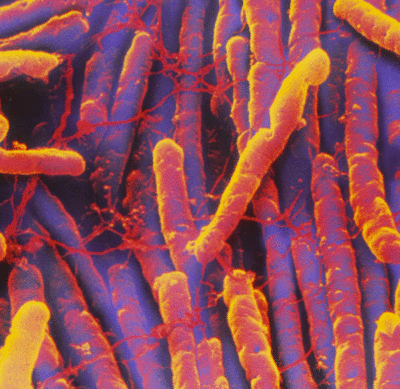Yersinia Pestis (Pathogenesis): Difference between revisions
(Created page with "Category:Pages edited by students of Tyrrell Conway at the University of Oklahoma {{curated}} [[Image:OULOGOBIANCO.JPEG|thumb|230px|left(this aligns the image to the left)...") |
No edit summary |
||
| Line 1: | Line 1: | ||
[[Category:Pages edited by students of Tyrrell Conway at the University of Oklahoma]] | [[Category:Pages edited by students of Tyrrell Conway at the University of Oklahoma]] | ||
{{curated}} [[Image:OULOGOBIANCO.JPEG|thumb|230px|left(this aligns the image to the left)|University of Oklahoma Study Abroad Microbiology in Arezzo, Italy[http://cas.ou.edu/study-abroad/]]] {{Uncurated}} | {{curated}} [[Image:OULOGOBIANCO.JPEG|thumb|230px|left(this aligns the image to the left)|University of Oklahoma Study Abroad Microbiology in Arezzo, Italy[http://cas.ou.edu/study-abroad/]]] {{Uncurated}} | ||
[[File:Clostridium difficile spore.gif|400px|thumb|right|Scanning electron microscope image of <i>Clostridium difficile</i>. From: Bioquell.com [http://www.bioquell.com/technology/microbiology/clostridium-difficile/]]] | |||
==Etiology/Bacteriology== | ==Etiology/Bacteriology== | ||
===Taxonomy=== | |||
| Domain = [[Bacteria]] | |||
| Phylum = [[Firmicutes]] | |||
| Class = [[Clostridia]] | |||
| Order = [[Clostridiales]] | |||
| Family = [[Clostridiaceae]] | |||
| Genus = [[Clostridium]] | |||
| species = [[C. difficile]] | |||
===Description=== | |||
==Pathogenesis== | ==Pathogenesis== | ||
===Transmission=== | |||
===Infectious dose, incubation, colonization=== | |||
===Epidemiology=== | |||
===Virulence factors=== | |||
==Clinical features== | ==Clinical features== | ||
===Symptoms=== | |||
The symptoms of Yersinia Pestis presents in different ways, but the three most common are bubonic, septicemic, and pneumonic plague. [[#References|[1]]] | |||
Bubonic Plague | |||
This type of plague usually results from the bite of an infected flea. Once infection sets, the patient has sudden onset of fever, headache, chills, weakness, and the development of swollen nodes known as buboes, where isolated bacteria multiply and grow. If not treated the bacteria can spread to other areas [[#References|[1]]] . | |||
Septicemic Plague | |||
This type of plague can either develop primarily or as a result from untreated bubonic plague. Symptoms from this include bleeding into the skin and other organs ranging to tissue blackening and death, especially in the fingers, toes, and the nose. [[#References|[1]]] | |||
Pneumonic Plague | |||
This type of plague either develops from inhaling infectious droplets or from untreated bubonic/septicemic plague and bacteria spreading to the lungs. At this point the plague is infectious and can be spread from person to person by infectious droplets. Symptoms from this type of plague include fever, headache, weakness, and a developing pneumonia that heightens symptoms of cough, chest pain and shortness of breath. [[#References|[1]]] | |||
===Morbidity and Mortality | |||
==Diagnosis== | ==Diagnosis== | ||
==Treatment== | ==Treatment== | ||
==Prevention== | ==Prevention== | ||
==Host Immune Response== | ==Host Immune Response== | ||
==References== | ==References== | ||
1. "Plague Symptoms." Centers for Disease Control and Prevention. Centers for Disease Control and Prevention, 25 July 2012. Web. 16 July 2014. <br> | |||
Created by {Krishna Manohar, Michael Grassi, Christina Cheng, Johnson Ong}, students of Tyrrell Conway at the University of Oklahoma. | |||
Revision as of 12:55, 16 July 2014


Etiology/Bacteriology
Taxonomy
| Domain = Bacteria | Phylum = Firmicutes | Class = Clostridia | Order = Clostridiales | Family = Clostridiaceae | Genus = Clostridium | species = C. difficile
Description
Pathogenesis
Transmission
Infectious dose, incubation, colonization
Epidemiology
Virulence factors
Clinical features
Symptoms
The symptoms of Yersinia Pestis presents in different ways, but the three most common are bubonic, septicemic, and pneumonic plague. [1] Bubonic Plague This type of plague usually results from the bite of an infected flea. Once infection sets, the patient has sudden onset of fever, headache, chills, weakness, and the development of swollen nodes known as buboes, where isolated bacteria multiply and grow. If not treated the bacteria can spread to other areas [1] . Septicemic Plague This type of plague can either develop primarily or as a result from untreated bubonic plague. Symptoms from this include bleeding into the skin and other organs ranging to tissue blackening and death, especially in the fingers, toes, and the nose. [1] Pneumonic Plague This type of plague either develops from inhaling infectious droplets or from untreated bubonic/septicemic plague and bacteria spreading to the lungs. At this point the plague is infectious and can be spread from person to person by infectious droplets. Symptoms from this type of plague include fever, headache, weakness, and a developing pneumonia that heightens symptoms of cough, chest pain and shortness of breath. [1] ===Morbidity and Mortality
Diagnosis
Treatment
Prevention
Host Immune Response
References
1. "Plague Symptoms." Centers for Disease Control and Prevention. Centers for Disease Control and Prevention, 25 July 2012. Web. 16 July 2014.
Created by {Krishna Manohar, Michael Grassi, Christina Cheng, Johnson Ong}, students of Tyrrell Conway at the University of Oklahoma.
